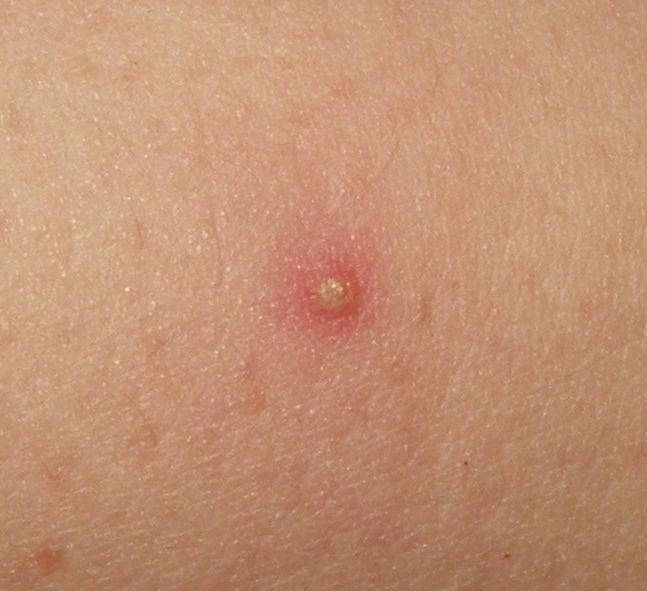Folliculitis is the infection and inflammation of one or more hair follicles. The condition may occur anywhere on the skin with the exception of the palms of the hands and soles of the feet. The rash may appear as pimples that come to white tips on the face, chest, back, arms, legs, buttocks and head.
Signs and symptoms
rash (reddened skin area)itching skinpimples or pustules located around a hair follicle, may be confused with chicken poxmay crust overtypically occur on neck, armpit, or groin areamay present as genital lesionsspreading from leg to arm to body through improper treatment of antibioticsMost carbuncles, boils, and other cases of folliculitis develop from Staphylococcus aureus and Pseudomonas aeruginosa.
Folliculitis starts with the introduction of a skin pathogen to a hair follicle. Hair follicles can also be damaged by friction from clothing, an insect bite, blockage of the follicle, shaving, or braids too tight and too close to the scalp. The damaged follicles are then infected with the bacterium Staphylococcus. Folliculitis can affect people of all ages.
Iron deficiency anemia is sometimes associated with chronic cases.
Staphylococcus aureus folliculitis.Hot-tub folliculitis is caused by the bacterium Pseudomonas aeruginosa. The folliculitis usually occurs after sitting in a hot tub that was not properly cleaned before use. Symptoms are found around the body parts that sit in the hot tub—typically the legs, hips, chest, buttocks, and surrounding areas. Symptoms are typically amplified around regions that were covered by wet clothing, such as bathing suits.Sycosis vulgaris, Sycosis barbae or Barber's itch is a staphylococcus infection of the hair follicles in the bearded area of the face, usually the upper lip. Shaving aggravates the condition.Gram-negative folliculitis may appear after prolonged acne treatment with antibiotics.Tinea barbae is similar to barber's itch, but the infection is caused by the fungus T. rubrum.Malassezia folliculitis, formerly known as Pityrosporum folliculitis, is caused by yeasts (fungi) of the genus MalasseziaHerpetic folliculitis may occur when herpes simplex virus infection spreads to nearby hair follicles - mostly around the mouth.Pseudofolliculitis barbae is a disorder occurring when hair curves back into the skin and causes inflammation.Eosinophilic folliculitis may appear in persons with impaired immune systems.Folliculitis decalvans or tufted folliculitis usually affects scalp. Several hairs arise from the same hair follicle. Scarring and permanent hair loss may follow. The cause is unknown.Folliculitis keloidalis scarring on the nape of the neck, most common among males of curly hair.Oil folliculitis is inflammation of hair follicles due to exposure to various oils and typically occurs on forearms or thighs. It is common in refinery workers, road workers, mechanics, and sheep shearers. Even makeup may cause it.Malignancy may also be represented by recalcitrant cases.- Topical antiseptic treatment is adequate for most cases
- Topical antibiotics such as mupirocin or Neomycin/polymyxin B/bacitracin ointment. Oral antibiotics may also be used. May also need to use probiotic treatment.
- Some patients may benefit from systemic narrow-spectrum penicillinase-resistant penicillins (such as dicloxacillin in US, or flucloxacillin in UK)
- Fungal folliculitis can worsen with antibiotics and may require an oral antifungal such as Fluconazole. Topical antifungals such as Econazole Nitrate may also be effective.
Folliculitis may recur even after symptoms have gone away.

